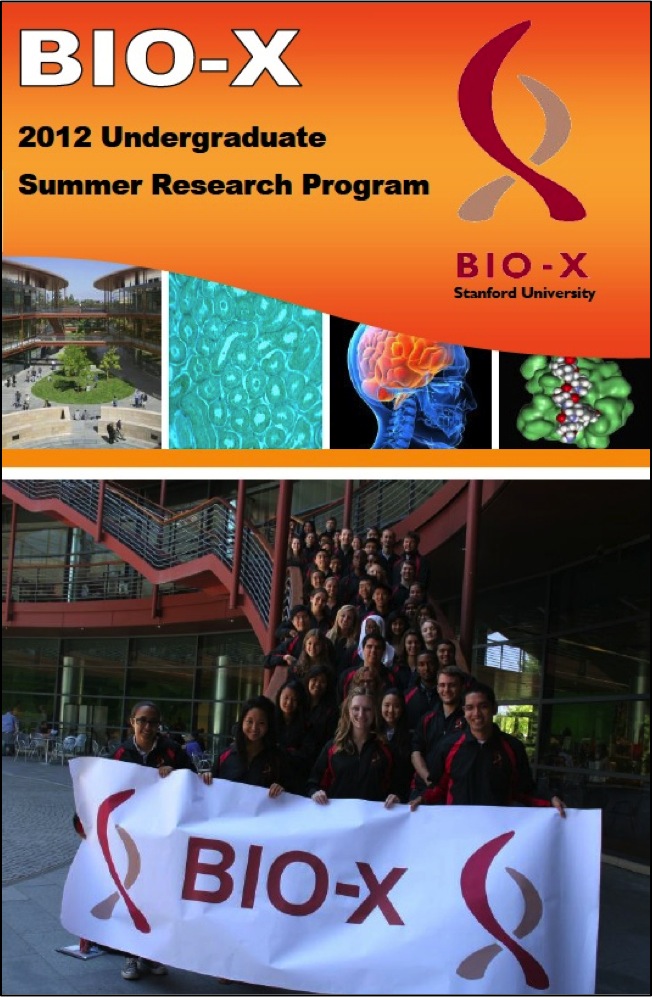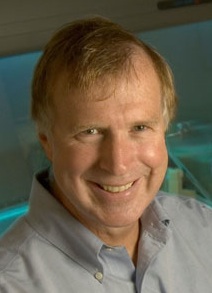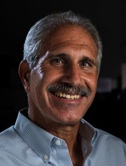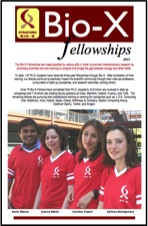
Welcome to the biweekly electronic newsletter from Stanford Bio-X for members of the Bio-X Corporate Forum. Please contact us if you would like to be added or removed from this distribution list, or if you have any questions about Stanford Bio-X or Stanford University.
Seed Grants
 SEED GRANTS FOR SUCCESS - Stanford Bio-X Interdisciplinary Initiatives Program (IIP)
SEED GRANTS FOR SUCCESS - Stanford Bio-X Interdisciplinary Initiatives Program (IIP)
The Bio-X Interdisciplinary Initiatives Program represents a key Stanford Initiative to address challenges in human health. The IIP awards approximately $3 million every other year in the form of two-year grants averaging about $150,000 each. From its inception in 2000 through the fifth round in 2010, the program has provided critical early-stage funding to 114 different interdisciplinary projects, involving collaborations from over 300 faculty members, and creating over 450 teams from five different Stanford schools. From just the first 5 rounds, the IIP awards have resulted in a 10-fold-plus return on investment, as well as hundreds of publications, dozens of patents filed, and most importantly, the acceleration of scientific discovery and innovation.
In 2012, Stanford Bio-X selected 23 new seed grant projects as the winners of the 6th round. Please go here to view the list of awardees, along with the titles of their projects and the abstracts of the research. Competition was intense as the awardees were chosen from 118 Letters of Intent (LOIs). Selection criteria included innovation, high-reward, and interdisciplinary collaboration. (To view the 114 other IIP projects that have been funded from the first 5 rounds, please click here.) In addition, SANOFI has also funded 4 new Bio-X IIP Seed Grant projects from round 6!
On Monday, August 26, 2013, Bio-X had its second annual IIP Symposium of the year at the Clark Center, which highlights projects that exemplify the Stanford Bio-X mission of crossing boundaries to bring about interdisciplinary research and solutions in the field of life bioscience. The symposium was a huge success with over 300 people attending this event, which included 8 oral presentations and 136 poster presentations. Recorded talks from the symposium will be uploaded soon. If you'd like to view the talks for previous symposia through the years, please click here.
We are cultivating and are highly successful in building meaningful collaborations with numerous corporate colleagues. New collaborations through our seed grant projects are highly encouraged. To learn about how to get involved, please contact Dr. Hanwei Li or Dr. Heideh Fattaey.
Fellowships
Every year, graduate students and postdoctoral scholars of Bio-X affiliated faculty are highly encouraged to apply for the Bio-X Fellowships, which are awarded to research projects that are interdisciplinary and utilize the technologies of different fields to solve different biological questions. Students are encouraged to work collaboratively with professors of different departments, thus creating cross-disciplinary relationships among the different Stanford schools. Our fellows have conducted exciting research, resulting in publications in high-impact journals and have been offered excellent positions in industry and academia. To date, Stanford Bio-X has a total of 152 Fellows.
On June 26th, Bio-X held its annual Bio-X Fellows Symposium, where there were four 15-minute oral presentations followed by one-minute spiels from current fellows. The 25 newest fellows selected this year were also announced, and about 100 attendees came to the symposium. Please click on the "Bio-X Fellows Symposium" link above for the agenda and titles of the talks, and on the icon of the brochure above for the updated and latest Bio-X Fellowships brochure.
To view the numerous projects that have been awarded over the years, please click here.
 BIO-X UNDERGRADUATE SUMMER RESEARCH PROGRAM
BIO-X UNDERGRADUATE SUMMER RESEARCH PROGRAM
The Bio-X Undergraduate Summer Research Program supports undergraduate research training through an award designed to support interdisciplinary undergraduate summer research projects. The program is an invaluable opportunity for students to conduct hands-on research, learn how to carry out experiments in the laboratory, and develop the skills to read and analyze scientific literature.
This program is eligible to Stanford students who want to work in the labs of Bio-X affiliated faculty. To date, 176 students have been awarded the opportunity to participate in the Bio-X Undergraduate Summer Research Program. This summer is Stanford Bio-X's 8th round of USRP.
Participating undergraduates are also required to present poster presentations on the research that they've conducted during the program. Please click here for title lists of past posters that our undergraduates have presented.
Many fruitful collaborations and relationships have been established with industry through fellowships. Please contact Dr. Hanwei Li or Dr. Heideh Fattaey if you'd like to learn more about how to get involved with these fellowship programs.
News
 Finding could potentially make iPS cells safer for use in humans
Finding could potentially make iPS cells safer for use in humans
Bio-X Affiliated Faculty Helen Blau
Bio-X Fellowship to Jennifer Brady
Induced pluripotent stem cells, or iPS cells, are a hot commodity right now in biology. The cells, which are created when non-stem cells are reprogrammed to resemble embryonic stem cells, have many potential uses in therapy and drug development. They're usually created by using a virus to add just four genes (selected because they are highly expressed in embryonic stem cells) to the cell to be reprogrammed. However, a molecular understanding of the transformation process is largely lacking, and the expression of one of the genes, called c-Myc, is frequently elevated in human cancers. This has given researchers and clinicians pause when considering the use of iPS cells in humans. Now researchers in the laboratory of Helen Blau, PhD, the Donald E. and Delia B. Baxter Professor, have found a replacement for c-Myc. They did so by fusing mouse embryonic stem cells with a human skin cell, or fibroblast, to create a bi-species product, called a heterokaryon, with a 3:1 nuclear ratio, skewed toward the stem cells. This ratio shifts the balance of cellular proteins to favor pluripotency and turns out be an excellent way to study the earliest steps of reprogramming. That's because factors in the developmentally flexible stem cell nucleus reprogram the more-staid skin cell nucleus quickly and efficiently, giving researchers a ring-side seat to the intricate transformation process. ... Blau is the senior author of the research, which was published Sept. 1 in Nature Cell Biology. Postdoctoral scholar Jennifer Brady, PhD, is the lead author.

 Approved cancer drug potentially could help treat diabetes, researchers find
Approved cancer drug potentially could help treat diabetes, researchers find
Bio-X Affiliated Faculty Calvin Kuo and Radiation Oncology Faculty Amato Giaccia
A pair of studies by researchers at the Stanford University School of Medicine has identified a molecular pathway — a series of interaction among proteins — involved in the development of diabetes. Furthermore, they have found that a drug already approved for use in humans can regulate the pathway. The findings were published online Sept. 15 in two articles in Nature Medicine. The studies, done in mice, identify a previously unexpected link between a low-oxygen condition called hypoxia and the ability of cells in the liver to respond to insulin. The drug, aflibercept (marketed as Eylea or Zaltrap), is used to treat metastatic colorectal cancer and a form of macular degeneration. Aflibercept is a member of a family of proteins that inhibit the vascular endothelial growth factor, or VEGF, pathway. It works by blocking the growth of the blood vessels into tumors and starving them of oxygen. The lab of Calvin Kuo, MD, PhD, professor of medicine, identified a series of protein interactions that link VEGF inhibitors and blood glucose levels. “We were surprised to find that this drug currently used in patients for cancer treatment had beneficial effects on diabetes in laboratory mice and could, potentially, in humans,” said Kuo, senior author of one of the Nature Medicine papers. Amato Giaccia, PhD, the Jack, Lulu and Sam Willson Professor of Cancer Biology, is senior author of the other paper. “Proteins involved in this pathway could also be targeted for the development of new diabetes therapies,” said Giaccia, who also is a professor and director of radiation oncology. His laboratory has identified a protein called PhD3 that could be a particularly attractive target.
 Faulty stem cell regulation may contribute to cognitive deficits associated with Down syndrome, study suggests
Faulty stem cell regulation may contribute to cognitive deficits associated with Down syndrome, study suggests
Bio-X Affiliated Faculty Michael Clarke
The learning and physical disabilities that affect people with Down syndrome may be due at least in part to defective stem cell regulation throughout the body, according to researchers at the Stanford University School of Medicine. The defects in stem cell growth and self-renewal observed by the researchers can be alleviated by reducing the expression of just one gene on chromosome 21, they found. The finding marks the first time Down syndrome has been linked to stem cells, and addresses some long-standing mysteries about the disorder. Although the gene, called Usp16, is unlikely to be the only contributor to the disease, the finding raises the possibility of an eventual therapy based on reducing its expression. “There appear to be defects in the stem cells in all the tissues that we tested, including the brain,” said Michael Clarke, MD, Stanford’s Karel H. and Avice N. Beekhuis Professor in Cancer Biology. The researchers conducted their studies in both mouse and human cells. “We believe Usp16 overexpression is a major contributor to the neurological deficits seen in Down syndrome.” Clarke is the senior author of the research, published Sept. 11 in Nature. Postdoctoral scholar Maddalena Adorno, PhD, is the lead author.
 Faulty internal recycling by brain’s trash collectors may contribute to Alzheimer’s, scientists find
Faulty internal recycling by brain’s trash collectors may contribute to Alzheimer’s, scientists find
Neurology & Neurological Sciences Faculty Tony Wyss-Coray
A defective trash-disposal system in the brain’s resident immune cells may be a major contributor to neurodegenerative disease, a scientific team from the Stanford University School of Medicine has found. Preliminary observations show that this defect appears in the brains of patients who died of Alzheimer’s disease, so correcting it may someday prove to be an effective way of preventing or slowing the course of the disease. “We were fortunate in being able to compare microglia — the brain’s own immune cells — from five patients who died of Alzheimer’s disease with five who died of other causes,” said Tony Wyss-Coray, PhD, professor of neurology and neurological sciences at the medical school and senior research career scientist at the Veterans Affairs Palo Alto Health Care System. “And we discovered that in Alzheimer’s disease, the microglia are defective. One of these cells’ main functions, removing garbage, is impaired." Wyss-Coray is the senior author of the study, published Sept. 4 in Neuron. The lead author was postdoctoral scholar Kurt Lucin, PhD.
 'Love hormone' may play wider role in social interaction than previously thought, scientists say
'Love hormone' may play wider role in social interaction than previously thought, scientists say
Bio-X Affiliated Faculty Robert Malenka
Researchers at the Stanford University School of Medicine have shown that oxytocin — often referred to as "the love hormone" because of its importance in the formation and maintenance of strong mother-child and sexual attachments — is involved in a broader range of social interactions than previously understood. The discovery may have implications for neurological disorders such as autism, as well as for scientific conceptions of our evolutionary heritage. Scientists estimate that the advent of social living preceded the emergence of pair living by 35 million years. The new study suggests that oxytocin's role in one-on-one bonding probably evolved from an existing, broader affinity for group living. Oxytocin is the focus of intense scrutiny for its apparent roles in establishing trust between people, and has been administered to children with autism spectrum disorders in clinical trials. The new study, published Sept. 12 in Nature, pinpoints a unique way in which oxytocin alters activity in a part of the brain that is crucial to experiencing the pleasant sensation neuroscientists call "reward." The findings not only provide validity for ongoing trials of oxytocin in autistic patients, but also suggest possible new treatments for neuropsychiatric conditions in which social activity is impaired.
Events
| Neurology & Neurological Sciences Sept 23, 2013, 4 pm - 5 pm Munzer Auditorium, Stanford, CA FRONTIERS IN AGING SEMINAR SERIES: "Single-cell genomics in aging" Speaker: Jan Vijg, PhD, Albert Einstein College of Medicine |
Biology September 23, 2013, 4 pm - 6 pm 393 Serra Mall, Herrin T-175, Stanford, CA "High-throughput genetic screens to define mechanisms of human neurodegenerative diseases" Speaker: Aaron Gitler, PhD, Stanford University |
| Neurosciences Institute Sept 26, 2013, 12 pm - 1 pm Clark Center S360, Stanford, CA "Circuit mechanisms underlying olfactory plasticity" Speaker: Yun Zhang, PhD, Harvard University |
Cancer Biology October 1, 2013, 12 pm - 1:30 pm Munzer Auditorium, Stanford, CA "Writing, reading and regulating histone ubiquitylation during the DNA damage response" Speaker: Daniel Durocher, PhD, University of Toronto |
Resources
| Stanford University |
| Stanford Bio-X |
| Bio-X Seed Grants The Stanford Bio-X Interdisciplinary Initiatives Program (IIP) provides seed funding for high-risk, high-reward, collaborative projects across the university, and have been highly successful in fostering transformative research. |
| Office of Technology and Licensing "Techfinder" Search the OTL Technology Portal to find technologies available for licensing from Stanford. |
| Stanford Center for Professional Development - Take advantage of your FREE membership! - Take online graduate courses in engineering, leadership and management, bioscience, and more. - Register for free webinars and seminars, and gets discounts on courses. |
| Stanford Biodesign Video Tutorials on how FDA approves medical devices A series of video briefs recently produced by the Stanford Biodesign Program teaches innovators how to get a medical device approved for use in the United States. This free, online library of 60 videos provides detailed information on the Food and Drug Administration regulatory process, short case studies and advice on interacting with the FDA. |
To learn more about Stanford Bio-X or Stanford University, please contact Dr. Hanwei Li, the Bio-X Corporate Forum Liaison, at 650-725-1523 or lhanwei1@stanford.edu, or Dr. Heideh Fattaey, the Executive Director of Bio-X Operations and Programs, at 650-799-1608 or hfattaey@stanford.edu.


